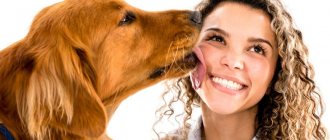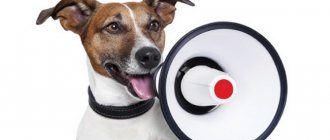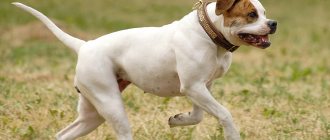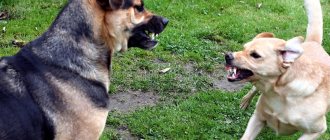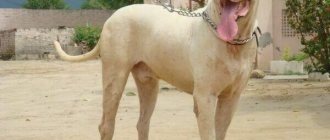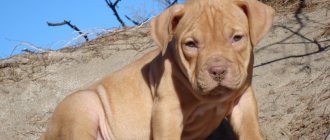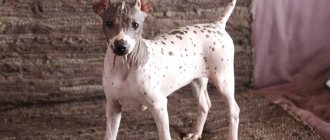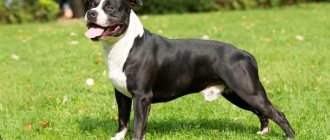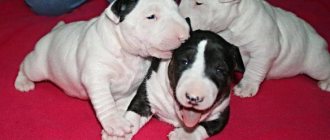| Origin: | USA |
| Usage: | companion dog |
| Color: | anything except marble |
| Dimensions: | 36 – 58 cm at the withers males, 33 – 56 cm females, body weight from 31 to 54 kg |
| Lifespan: | 12 years |
The American Bully is a young breed of dog, bred in America in the 90s. Because of their menacing, ponderous and somewhat clumsy appearance, opponents of dogs call them jocks, bodybuilders and even crocodiles on their paws. However, in the USA and Europe there are more and more fans of these affectionate and friendly pets.
Subspecies
Since Bullies were bred by several breeders at the same time, there is no single conformation. The differences are significant in size and weight. The following types of “American jocks” are distinguished:
- Standard. Considered to be the most compliant with the standard. The height of males at the withers is 43 – 51 cm, females – 40 – 48 cm.
- Classic. The sizes of the dogs are the same as those of the “standards”. But this type has a lighter frame and weighs less.
- Extreme. In contrast to the “classic” ones, these dogs are heavier and more massive, although their height is the same. This is also the only breed variety in which a dewlap on the neck and a slight elevation of the tailbone are allowed.
- Pocket or Pocket. The smallest pets, height for males is 36 - 43 cm, for females - 33 - 40 cm.
- Bully exotic. The exotic is even smaller in size than the “pocket”. But this variety is recognized by few dog handlers - it is at the stage of formation.
- HL (Extra Large or XL). The largest representatives. Height at the withers for males is 51 – 58 cm, for females – 48 – 56 cm. If the height of males reaches 60 cm, they speak of the XXL or extreme subspecies.
The types of bullies are not limited by weight. The main thing is that it matches the height, and any types are proportionally built without signs of thinness or obesity.
Characteristic
FCI breed standard: not recognized
The American Bully is often called a freak - the stocky and massive dog evokes versatile emotions.
There are five breed types:
- standart (standard);
- classic;
- pocket;
- extreme;
- XL
The breed standard is common to all types, but the last four have some differences. They differ in body structure, size and proportions.
The head of the American Bully is very heavy, wide and large. The length of the head is average, the skull is wide. The muscles of the cheeks and cheekbones are strongly expressed, the ears are set high on the head. The dog's eyes are deep-set and can be any shade except blue. The eyes are oval in shape, the eyelids are well pigmented. The third eyelid does not stand out.
The bully's muzzle is short and wide, square in shape, the transition to the skull is clearly pronounced. The jaws are clearly defined, the lower one is strong. The bite is scissor-shaped, the lips do not fit tightly and may be damp. The nose can be any color except pink.
The American Bully's neck is muscular, slightly arched, and covered with slightly loose skin. From the shoulders to the skull the neck narrows significantly.
The body is massive, yet compact and collected. The length of the body is average, almost equal to the width - when looking at the dog, you create a feeling of incredible power. The chest is deep, well filled, wide - reaches the elbows. The back is short, sloping down towards the croup. A high rump is allowed from the base of the tail. The body format is square.
The front legs are spread wide, the shoulders are strong, with pronounced muscles. Elbows are turned outward, up to 45⁰. The hind limbs are developed, the hock joints are low. When viewed from behind, the legs are parallel. The saber-shaped tail is set low and lowered when calm.
The gait of the American Bully is powerful, without swinging - the dog pushes strongly with its hind limbs. Some clumsiness is acceptable in extreme and XL dogs.
Breed faults:
- narrow and long muzzle, lack of stop;
- multi-colored eyes;
- albinism;
- thin neck;
- straight bite, underbite, overshot;
- snub nose;
- hind legs like a wheel;
- turned out hocks;
- narrow croup;
- short shoulders, elbow inversion;
- the tail is ringed or too long;
- flat paws;
- swinging gait, ambling.
Disqualifying faults:
- aggression towards people;
- merle color;
- eye albinism;
- cryptorchidism;
- deafness;
- bobtail.
The bully of the classic type is angular and heavy, differs from the usual one in having lighter bones and less muscle mass. In structure it resembles the old type of American Pit Bull Terrier.
The Pocket variety is several centimeters lower than the standard Ambulli. Otherwise, he corresponds to the breed standard.
The Extreme type is more massive and bony, the structure of its body is clearly expressed, the muscles simply bulge. Body weight is more than standard.
Other differences:
- incomplete lip line;
- loose skin on the neck;
- high croup;
- everted hocks.
The XL bullies are significantly taller than the standard ones and have the same features as the Extreme ones.
Dimensions, weight and height of the breed
The dimensions of a standard bully are 43-51 cm for males and 40-48 cm for females.
For varieties, the height at the withers varies:
- pocket – 40-43 cm;
- XL and extreme – 58-61 cm.
The weight is also different - for the bull pocket the weight is about 30 kg, and for the XL type - 58 kg. Deviations from weight and height parameters are acceptable, the main attention is paid to the proportions of the dog.
Possible colors
The coat is dense, short and glossy. Straight hair, curls and waves are not allowed. Can be any color except merle.
Puppy weight by month
There are different types of American Bullies, and their puppies weigh differently. The breed is new, and there is no exact data on the optimal weight-to-age ratio. Large and small puppies can be born in one litter.
Lifespan
Breeders estimate that bullies live up to 13 years. For a dog of this type, this is a long time. To keep your dog looking young longer, you should have your dog's health checked annually by a veterinarian.
Allergenicity
The breed is no less allergic than others of its kind. The owner may have a reaction to the animal's fur or skin, as well as to saliva and feces.
Standard and exterior
The standard for American bulls is still being developed. Different kennel clubs offer their own description of the breed and adjustments to the exterior. Today the most popular standard is ABKC, which most breeders rely on.
General impression
Externally, the American Bully gives the impression of a strong, stocky, extremely muscular dog with a strong bone structure. The characteristics of the breed describe the movements as light and powerful, despite the apparent awkwardness of the physique.
Head
The shape is close to a square. Heavy and large, with a wide forehead and deep stops. The muzzle is short, but not flattened. Cheeks and lips are well defined.
The gaze is open, direct. The eyes are oval or almond-shaped. The pigment circle should be clearly defined. Any color is allowed, except albinism. Blue shades and heterochromia are undesirable. Any shade of the nose is also allowed, except light pink.
The jaws are powerful, well defined and bordered by dense lips. Scissor bite. The ears can be cropped or left hanging.
Frame
The American Bully breed has a muscular, massive, square-shaped body with a barrel-shaped and deep chest. The front legs are widely spaced and the back is straight. The tailbone should be significantly lower than the withers. The neck is powerful, the transition from head to body is sharp.
The breed standard prohibits tail docking. At rest it should be lowered down, when walking and running it should be raised to the back. The tail does not fall over the back or curl.
Limbs
The front legs are strong, almost straight, the hind legs should be parallel. The pads are elastic, with the fingers gathered into a ball.
Coat and color
The coat is short and lies close to the body. Shiny, smooth, up to 1 cm long. Curly or wavy hair is considered a fault; long hair is a disqualifying fault.
Any color is acceptable: black, white, brown, tri-color, etc. The exception is merle - alternating light and dark areas of the same color.
Terrible on the face but kind on the inside
Many people are scared by the appearance of their pets. Even photos of an American Bully look scary. People who are not familiar with the breed prefer to walk around dogs 10 kilometers away.
But if you get to know the animals, there will be no trace of fear left. All reviews from the owners claim that these are good-natured, friendly and endlessly sociable dogs. They adore every member of the family, are ready to lick all the children to bits and forgive the kids any pranks.
Bullies have a very high pain threshold. Therefore, the dog graciously tolerates children's pinching, kicking, tail and ear pulling, and behaves very carefully and reservedly with children.
However, it is not for nothing that the blood of fighting breeds flows in the veins of bulls. If the owner is attacked, the pet will fiercely defend him.
Favorites usually treat strangers favorably, but are somewhat wary. But the relationship with dogs and other pets is ambiguous. It all depends on the character of the dog: one calmly tolerates the proximity of other animals, the second will certainly want to fight with someone else’s dog or bite the cat.
However, the American Bully usually perceives other dogs as competitors, so fights and skirmishes are not uncommon.
It must be remembered that the character of the American Bull greatly depends on upbringing. With early socialization and a gentle approach, the dog will grow up to be friendly. If a pet sees cruelty and rudeness since childhood, it will become aggressive.
Education and training
The intelligence and obedience of the American Bully makes the training process less energy-consuming for the owner. The main rule is a gentle approach. These dogs are non-aggressive, so they require the same from their owner. The best method is positive reinforcement.
Important! Provide your pet with toys so that he is not bored when alone and does not throw out his energy on furniture, things or shoes.
The training process should not exhaust your pet. It is better to do frequent but short sessions. Remember: physical aggression and rudeness will only bring harm, to the point that the American Bully will lose confidence in you. And then it is very difficult to restore a warm connection with your pet.
Encouragement is an important part of training. Be sure to cheer your dog up with something tasty or just praise. When training, you must be gentle, patient, but at the same time persistent. Only then will you be able to raise a good companion.
Application
The main purpose of bullies is as a companion. Sometimes it is used as a working dog - to guard property or protect people.
However, the watchman from “American Bruiser” is bad. He lacks aggression and possessiveness. But in terms of security qualities, everything is excellent - as soon as the dog senses a threat to himself or family members, he becomes a fearless defender. He will not be frightened by any threats - the pet will stand to death.
Upbringing
The main thing you need to know when getting an American Bully is that they take a long time to grow. A very long time. Physically, pets reach maturity by 3 years. And their psychotype is similar to boxers - dogs will always remain playful puppies.
Therefore, you need to raise a bull gently. No cruelty or physical punishment. The dog is smart and easily obeys. You just need to win her love and respect.
Socialization
Socialization is very important for the breed. If an American Bully puppy is not raised properly, it will develop aggression.
You need to start introducing your baby to other people and animals as early as possible. He is accustomed to all possible situations: communicating with children, adults, dogs and interaction with other pets, traveling by transport, being in public places.
It is important to ensure that in any situation the dog behaves calmly and unquestioningly follows commands. An uncontrollable bully, which contains about 50 kg of steel muscles, is dangerous for others and the owner.
Training
Bullies are highly trainable. They have a well-developed intellect, they are aimed at submission and want to please the owner. How many repetitions it will take to learn a new command depends on the mental abilities of the particular dog. But usually only 3 – 5 is enough.
However, successful training is possible if the owner places himself higher in the hierarchy. With the “big guys” this is quite difficult. They love to test the strength of the leader and are not averse to taking the place of the leader of the pack. In addition, pets are quite stubborn. Therefore, American Bullies are not the best choice for a beginner.
The basics of proper behavior for a puppy begin to be taught from the first days of its arrival in the house. Basic commands are learned from 2 to 3 months. Within six months, it is advisable to undergo OKD - a general training course. You can engage in protective guard service from the age of 2.
Character
The American Bully is very intelligent and is rightfully considered an excellent family companion dog. Such a pet is sincerely happy every time he manages to please his owner.
Once in a new family, in a new home, the bullypit quickly joins the team and treats all members of the household equally friendly, even tenderly. But among all, he considers only one to be the master.
Prolonged loneliness has a bad effect on both his character and health. After accompanying the owner to work, he will patiently wait for his return, but if he is away and does not return at the usual time, the dog experiences stress.
Despite its friendly disposition, the American Bully is prone to dominance. If the owner shows weakness, the dog will take advantage of the moment and try to take the main place in the house. As a result, he will become disobedient and uncontrollable. He needs an owner with willpower.
Representatives of the breed get along well with children. They are able to tolerate children's antics for a long time. They play outdoor games for hours. For a child, this is a great friend and at the same time a guard. But it is strictly not recommended to leave children alone with bullies. The dog is strong, so it can inadvertently cause harm.
The American Bully's guard instinct is well developed, but he cannot be called an ideal guard. The breed is devoid of the aggression inherent in fighting and guard dogs towards strangers.
The American Bully easily makes contact and shows a friendly interest in house guests. Although it can scare uninvited guests with just its appearance.
In situations where the owner or the dog himself is in danger, instantly turn into a formidable fighting dog that knows no fear.
Mature males have a pugnacious disposition. They often start quarrels with their own kind both on their territory and in public places. Early socialization and serious training will help to cope with this.
Although the character and behavior are individual for each individual dog.
Features of maintenance and care
It is best to keep an American Bully in a private or country house. This is a fairly active breed that needs a lot of space and free access to the yard. Dogs also get along well in an apartment, but only if you train with them every day for at least 1 hour and walk for at least another 2 hours.
The American Bully should not be kept in an enclosure. They do not tolerate heat or cold well. But the main thing is a companion dog, for which lack of communication is like death.
The breed is said to be the easiest to care for. It will take no more than 2 hours to maintain a good appearance.
Grooming
Short fur needs to be brushed once a week with a massage brush. Moreover, the procedure will only take a few minutes.
The rest of the grooming is standard:
- if the claws do not grind down on their own, they are trimmed once a month;
- ears and eyes are regularly examined, wax and nitrous are removed;
- brush your teeth weekly.
Bullies should be examined regularly for wounds. Since they have a high pain threshold, they can withstand all damage.
Bathing
They bathe the dogs when they get dirty. On average, bath procedures are needed once every 3 months. If the owner does not like the smell of the dog, then you can wash the pet more often, but not more than once a month. It is necessary to use a special shampoo for short-haired breeds.
Paws are washed after every walk. If the wool becomes dirty, wipe it with a damp sponge. To remove the unpleasant odor, you can add a couple of tablespoons of vinegar to the water.
Walk
They walk the dog every morning and evening. It is not advisable to let her off the leash in the city. For free walking you need secluded, safe places. It is advisable to take your pet out into nature at least once a week.
Since dogs do not tolerate cold and heat well, they are dressed in winter, and in summer they are monitored so that the dogs do not overheat. In hot weather and severe frost, the duration of walks is reduced. Pets feel best in a temperate climate.
To strengthen the spine and increase muscle mass, a belt with weights is worn on the dog during walks.
Feeding
The American Bull's diet is standard. Follow the basic rules of feeding dogs.
If your dog eats ready-made food, you need to choose super-premium or holistic brands. The daily menu for pets on a natural diet should consist of:
- 70% pure lean meat - veal, turkey, chicken, rabbit;
- offal - liver, hearts, scars, udders;
- porridge - rice, buckwheat;
- fruits and vegetables - zucchini, cucumbers, pumpkins, apples, pears and others;
- raw eggs.
Fermented milk products are given to representatives of the American Bully breed carefully. Kefir or cottage cheese can be introduced into the diet no more than 2 – 3 times a week.
Puppies up to six months are fed 5-6 times a day in small portions. Juniors up to one year - 3-4 times a day. Adult dogs are given food twice a day.
Health
Bully was bred recently, and not all “breed” diseases have been identified. Therefore, it is highly advisable to have a full examination at a veterinary clinic every six months in order to promptly identify possible pathologies.
However, overall this is a healthy, robust breed. Average life expectancy is 8-14 years.
Diseases
American Bullies are genetically prone to:
- hip dysplasia;
- cardiovascular pathologies;
- demodicosis;
- congenital heart failure;
- dislocated kneecaps;
- cataracts;
- cleft lip;
- problems with teeth.
If the American Bull has become weak, has shortness of breath, drowsiness, or moves poorly, it is necessary to urgently show the dog to the veterinarian.
Vaccinations
Vaccination is the only way to protect your pet from deadly infections. Dogs are vaccinated as standard:
- at 8 weeks they give a comprehensive vaccination against canine distemper, hepatitis, enteritis, adenovirus;
- at 12 weeks - second vaccination;
- after 2 weeks or six months - rabies vaccination;
- at 6 – 7 months – revaccination;
- Dogs over 12 months old are vaccinated annually.
American Bully Diseases
American Bullies delight their owners for an average of 12–13 years. They are classified as breeds with good health, but representatives have a predisposition to certain ailments:
- Heart failure. The disease most often occurs in older dogs, but can be a consequence of infectious diseases. The dog develops shortness of breath on exertion, lethargy, swelling of the limbs, and pale mucous membranes. To diagnose the disease, you need to contact a veterinarian who will prescribe medications to support heart function.
- Joint diseases (arthritis - joint destruction, arthrosis - changes in cartilage tissue with inflammation, etc.). The main reason is poor diet and excessive exercise. Problems manifest themselves as a decrease in the animal’s activity, lameness, and difficulty climbing stairs. It is important to go to the hospital at the first symptoms - timely detection of the disease will make it easier and faster to deal with it. Depending on the type of problem, the dog may be prescribed chondroprotectors, anti-inflammatory and painkillers, or even surgery.
Mating
Since bullies “mature” for a long time, the first mating is carried out no earlier than 1.5 years. It is advisable to breed a female dog after her 3rd heat.
Before knitting you must:
- treat the dog for parasites;
- get all vaccinations;
- get tested for possible infections.
Important! Only completely healthy animals are bred.
For successful fertilization, 2 matings are required with a break of a day. Mating is best done in the male dog's territory. For the next few days, the bitch is not allowed off the leash - the heat is still ongoing, and she may rush off to look for another father for the puppies.
How to choose a puppy
Buying a kitten is a responsible undertaking. Even more trouble is added if you take such a young and popular breed as the American Bully.
The American Bully and Pitbull are somewhat similar, especially during puppyhood. Therefore, baby Pit dogs are often sold to inexperienced owners under the guise of a new breed.
It is better to take puppies from large nurseries. The ideal option is to buy in the USA, but Americans are not willing to give breeding and show animals to foreigners. Therefore, it is worth taking a closer look at clubs in Russia.
It is desirable that both parents are from America. Before you buy a puppy, you need to get to know the parents - the kids will inherit their physique and disposition.
The ideal Bully puppy should:
- have a good appetite;
- easy to make contact;
- be playful, not aggressive;
- have no external defects - excessive fatness, thinness, nitrous eyes, dirty ears indicate health problems.
It is imperative to check the pedigrees of the parents, passports of the mother, father and puppies. Babies must be vaccinated.
Don't be afraid to ask breeders questions. Adequate owners love them - this shows the interest and responsibility of the future owner. Unscrupulous “divorcees” avoid questions.
History of the breed
Until 1990, the breed did not exist at all. Her ancestors have been known to the world for at least two hundred years, or even more. After all, a very long time ago in England such a bloody sport as bull-baiting was popular, when a dog attacked a chained bull. In 1835 it was officially banned and became illegal. But dog fighting was not prohibited and became incredibly popular.
At that time, these fights were fought between Old English Bulldog and Terrier mixes, today known as Bulls and Terriers. Over time they became a purebred breed, splitting into the Staffordshire Bull Terrier and the Bull Terrier. In the early 1800s, Staffordshire dogs came to the United States, where they became very popular under the name American Pit Bull Terrier.
In the 1990s, a lot of breeders in the United States tried to crossbreed the American Pit Bull Terrier and the American Staffordshire Terrier. This happened for several reasons.
The working qualities of the American Pit Bull Terrier are so high that he exhibits behavior that is too energetic for a pet. He also has incredibly high aggression towards other dogs, which is difficult to control.
It is unclear whether the breeders' goal was to improve their character or to create a new breed, as its history is complicated. The American Bully is unusual in that it was created not by one person or club, but by dozens, if not hundreds of breeders in the United States.
Many of them worked without contact with others. The focus of these efforts was in Virginia and Southern California, but the fashion quickly spread throughout the country.
Even the time when the name of the breed appeared, not to mention when it began to be called a breed, is a mystery. Bullies became widely known at the beginning of the 21st century, but have become popular only in the last 5-8 years.
Breeders crossed Pit Bull and Amstaff, but it is believed that other breeds were also used. Undoubtedly, among them there was an English bulldog, a Staffordshire bull terrier, an American bulldog, and a bull terrier.
Since many breeders took part in the creation of the breed, often having no idea what they wanted, the American Bully turned out to be very diverse in appearance. They were both much smaller than a real pit bull terrier, and significantly larger.
There is no need to talk about colors. Body structure, type, proportions are much more varied than other purebred breeds, although in general they are very stocky, incredibly muscular. However, they still resembled their ancestor, and most casual people confused him with other breeds.
Like its ancestor, the American Bully has inspired the creation of many clubs and organizations. Among them: American Bully Kennel Club (ABKC), United Bully Kennel Club (UBKC), Bully Breed Kennel Club (BBKC), United Canine Association (UCA). In Europe, the European Bully Kennel Club (EBKC) has been created, which has offices in Malta, France, Switzerland, Holland, Germany, Belgium and Italy.
The appearance of the breed did not cause delight among supporters of classic dogs. Most pit bull breeders consider the American Bull to be an intrusion into their breed, a dog that lacks both conformation and working qualities.
Amstaff breeders share the same opinion. Their concern is justified, since these dogs are often crossed with each other, which leads to the appearance of mixed breeds and even greater confusion.
Even though American Bullies are a young breed, they are popular in the United States. The population of registered dogs is quite large, but there are even more of those that are not registered.
Although there are no statistics, it appears that there are already more of these dogs in the United States than are needed to be officially recognized by canine organizations. In addition, there are quite a lot of them in Europe and Russia. Today, American Bullies are companion dogs, but they are also capable of working tasks.
How much do puppies cost?
The average price of the American Bully breed in Russia is 150-200 thousand rubles. Bully puppies cost about $5,000 overseas. Additionally, you will need to pay shipping costs.
Pedigree American Bully puppies will not cost less. Cheaper pets, at best, have flaws in appearance (the so-called pet class) or disqualifying defects. At worst, these are mestizos without any breed characteristics and with serious health problems.
